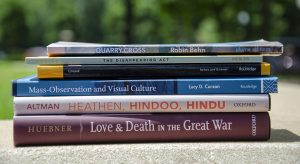
What are you reading this summer? Here are seven books by A&S faculty, plus the latest by distinguished scientist and UA alumnus Dr. Edward O. Wilson:
Grease: Gender, Nostalgia and Youth Consumption in the Blockbuster Era
By Barbara Brickman (New College, bjbrickman@nc.ua.edu)
Grease: Gender, Nostalgia and Youth Consumption in the Blockbuster Era examines one of the highest grossing film musicals of all time and its place as a model for the modern blockbuster ushered in in the 1970s. Brickman describes, “I also wanted to show that the film is not the regressive piece of 1950s nostalgia everyone takes it for. Within its traditional musical love story set in 1959, Grease offers a new version of the teenager, dressed in 1950s garb but grounded in the 1970s and reflective of the social changes and rights movements of the decades between its setting and release date.”
“I hope the book encourages readers to take a second look at a film they probably already know very well and pause from singing those infectious musical numbers long enough to consider its historical and social significance.”
Love & Death in the Great War
By Andrew Huebner (History, ahuebner@ua.edu)
Intertwining untold stories of ordinary men and women during World War I, Andrew Huebner argues that Americans viewed the war as a battle for home and family.
“This book started with something personal, my interest in the story of Arthur Huebner, my grandfather’s brother. It then expanded to include several other families whose experiences collectively led me to the book’s main argument: Americans understood the Great War as a fight for the survival of the family, though that understanding absorbed all manner of challenges during the war and in the years thereafter,” says Huebner.
The Disappearing Act
By Sara Pirkle Hughes (English, sphughes1@ua.edu)
In her first collection of poems, Hughes uses the Southern tradition of storytelling and formal elements to examine her own personal history and family stories.
“The Disappearing Act is essentially about the fallible nature of memory. The poems in the collection explore how memory shapes identity, with each poem attempting to recapture a moment in time that has been lost or has ‘disappeared,’ says Hughes.
Heathen, Hindoo, Hindu: American Representations of India, 1721-1893
By Michael Altman (Religious Studies, michael.altman@ua.edu)
Before the twentieth century, Hinduism was unknown in the United States. This book explores how Americans imagined religion in India explores how religion functions to construct categories of ‘us’ and ‘them.’
Michael Altman explains, “When Americans described ‘those people’ in India, it was really a discussion of what they thought counted as ‘American.’ Rhetoric about ‘them’ is used to define ‘us.’ I hope readers not only learn about the encounter between America and India during the nineteenth century but also see how it is an example of something that continues to happen all around us.”
Mass-Observation and Visual Culture: Depicting Everyday Lives in Britain
By Lucy Curzon (Art & Art History, lcurzon@ua.edu)
At the end of the 1930s, Britain was still reeling from the Great Depression, the king had just abdicated the throne, and threats from Germany and Italy were looming prior to the Second World War. Founded in 1937, Mass-Observation was a British anthropological research group that recorded everyday life in Britain. Mass-Observation and Visual Culture – Depicting Everyday Lives in Britain critically analyzes the role that visual culture played in the early development of the innovative Mass-Observation.
Curzon explains, “The Mass-Observers used visual culture to take a barometer of national identity so that Britons might use the information to orient themselves; so that they would know who they were, their goals and objectives.”
Quarry Cross
By Robin Behn (English, rbehn@ua.edu)
Robin Behn’s fifth book of poems, Quarry Cross, takes its title from an old Irish fiddle tune of the same name. Several poems in the book such as “The Star Above the Garter,” “The Rights of Man,” and “Quarry Cross,” are based upon the sounds and titles of traditional tunes that inspired them, and are meant to be read aloud with the music. You can listen to the poems-inside-music at robinbehn.com, where Behn herself, a flute player as well as a poet, is among the musicians. Other poems in Quarry Cross include elegies, love poems, poems about the nature of art, poems about dreams, and “Tuscaloosa and Beyond,” a poem about the 2011 EF4 tornado.
“I’m drawn to the sound of language just as much as the meaning of words and the stories they tell. I want to create an experience for the reader that is full of emotion,” says Behn.
Culture and the Individual: Theory and Method of Cultural Consonance
By William Dressler (Anthropology, wdressle@as.ua.edu)
Cultural consonance is the degree to which individuals incorporate into their own beliefs and behaviors the prototypes for belief and behavior encoded in shared cultural models. Pulling together more than twenty-five years of research and focusing particularly on the field of health, Dressler examines how cultural consonance can be measured and what it reveals about the relationship between individuals and the treatment of culture.
The Origins of Creativity
By E.O. Wilson
Written by one of The University of Alabama’s most distinguished alumni, The Origins of Creativity examines the roots of human creativity. By reflecting on language, storytelling, and art, Wilson chronicles the evolution of creativity. Our achievements in science and the humanities make humans an advanced species, but The Origins of Creativity calls for a “Third Enlightenment,” in which we seek to understand our relationship with millions of other species in the natural world.